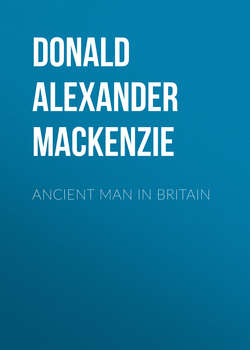Ancient Man in Britain

Реклама. ООО «ЛитРес», ИНН: 7719571260.
Оглавление
Donald Alexander Mackenzie. Ancient Man in Britain
FOREWORD
PREFACE
CHAPTER I. Britons of the Stone Age
CHAPTER II. Earliest Traces of Modern Man
CHAPTER III. The Age of the "Red Man" of Wales
CHAPTER IV. Shell Deities and Early Trade
CHAPTER V. New Races in Europe
CHAPTER VI. The Faithful Dog
CHAPTER VII. Ancient Mariners Reach Britain
CHAPTER VIII. Neolithic Trade and Industries
CHAPTER IX. Metal Workers and Megalithic Monuments
CHAPTER X. Celts and Iberians as Intruders and Traders
CHAPTER XI. Races of Britain and Ireland
CHAPTER XII. Druidism in Britain and Gaul
CHAPTER XIII. The Lore of Charms
CHAPTER XIV. The World of Our Ancestors
CHAPTER XV. Why Trees and Wells were Worshipped
CHAPTER XVI. Ancient Pagan Deities
CHAPTER XVII. Historical Summary
Отрывок из книги
This volume deals with the history of man in Britain from the Ice Age till the Roman period. The evidence is gleaned from the various sciences which are usually studied apart, including geology, archæology, philology, ethnology or anthropology, &c., and the writer has set himself to tell the story of Ancient Man in a manner which will interest a wider circle of readers than is usually reached by purely technical books. It has not been assumed that the representatives of Modern Man who first settled in Europe were simple-minded savages. The evidence afforded by the craftsmanship, the burial customs, and the art of the Crô-Magnon races, those contemporaries of the reindeer and the hairy mammoth in South-western France, suggests that they had been influenced by a centre of civilization in which considerable progress had already been achieved. There is absolutely no evidence that the pioneers were lacking in intelligence or foresight. If we are to judge merely by their skeletons and the shapes and sizes of their skulls, it would appear that they were, if anything, both physically and mentally superior to the average present-day inhabitants of Europe. Nor were they entirely isolated from the ancient culture area by which they had been originally influenced. As is shown, the evidence afforded by an Indian Ocean sea-shell, found in a Crô-Magnon burial cavern near Mentone, indicates that much has yet to be discovered regarding the activities of the early people.
In writing the history of Ancient Man in Britain, it has been found necessary to investigate the Continental evidence. When our early ancestors came from somewhere, they brought something with them, including habits of life and habits of thought. The story unfolded by British finds is but a part of a larger story; and if this larger story is to be reconstructed, our investigations must extend even beyond the continent of Europe. The data afforded by the "Red Man of Paviland", who was buried with Crô-Magnon rites in a Welsh cave, not only emphasize that Continental and North African cultural influences reached Britain when the ice-cap was retreating in Northern Europe, but that from its very beginnings the history of our civilization cannot be considered apart from that of the early civilization of the world as a whole. The writer, however, has not assumed in this connection that in all parts of the world man had of necessity to pass through the same series of evolutionary stages of progress, and that the beliefs, customs, crafts, arts, &c., of like character found in different parts of the world were everywhere of spontaneous generation. There were inventors and discoverers and explorers in ancient times as there are at present, and many new contrivances were passed on from people to people. The man who, for instance, first discovered how to "make fire" by friction of fire-sticks was undoubtedly a great scientist and a benefactor of his kind. It is shown that shipbuilding had a definite area of origin.
.....
Then follows, in France, the Azilian stage (named after Mas d'Azil, a town at the foot of the Pyrenees) which is regarded as the link between Upper Palæolithic and Neolithic. But in Western Europe, including Britain, there were really three distinct cultures during the so-called "Transition Period". These are the Azilian, the Tardenoisian, and the Maglemosian. These cultures were associated with the movements of new peoples in Europe.
The pre-Chellean flints (also called Eoliths) were wrought by the pre-Neanderthals. Chellean probably represents the earliest work in Europe of a pre-Neanderthal type like Piltdown man. The most characteristic implement of this phase is the coup de poing or pear-shaped "hand axe", which was at first roughly shaped and unsymmetrical. It was greatly improved during the Acheulian stage, and after being finely wrought in Mousterian times, when it was not much used, was supplanted by smaller and better chipped implements. The Neanderthals practised the Mousterian industry.
.....